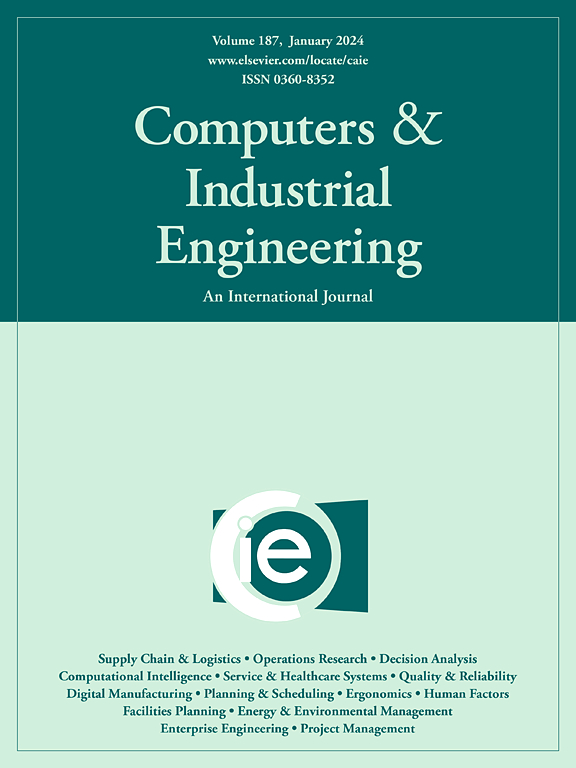异构升降机四向梭式紧凑存储检索系统的检索调度
IF 6.5
1区 工程技术
Q1 COMPUTER SCIENCE, INTERDISCIPLINARY APPLICATIONS
引用次数: 0
摘要
四向梭式异构升降机紧凑储取系统作为一种新兴的分层梭式系统,利用四向梭进行分层仓运输;层间移动由两种不同类型的升降机执行,其中梭式升降机运输梭,料斗式升降机运输料斗。由于筒式升降机通常比穿梭式升降机便宜,因此采用两种升降机可以减少投资和运营成本。该系统中检索请求的执行需要三种设备的协同操作,使得调度优化问题既复杂又具有挑战性。本文研究了检索调度问题,其重点是确定穿梭车和升降机的任务顺序以使最大完工时间最小化。我们建立了一个混合整数规划模型,并提出了一个精确的基于逻辑的Benders分解算法。此外,我们开发了一种有效的两阶段启发式方法,为大规模实例提供接近最优的解决方案。两阶段启发式方法始终优于其他调度策略,提供更短的完工时间、更低的平均检索时间和更少的资本投资。数值实验表明,增加梭式和箱式升降机的数量比增加梭式升降机的数量能更显著地降低总跨度。此外,垃圾箱升降机比穿梭升降机更具成本效益;用升降机部分替代穿梭升降机可获得可观的经济效益,当升降机占升降机总投资的20%时,效益最高。此外,将升降机放置在拣选轨道的中点可以产生最小的完工时间。这些发现为优化此类系统性能的设备配置提供了有价值的见解。本文章由计算机程序翻译,如有差异,请以英文原文为准。
Retrieval scheduling in four-directional shuttle-based compact storage and retrieval systems with heterogeneous lifts
As an emerging tier-to-tier shuttle-based system, the four-directional shuttle-based compact storage and retrieval system with heterogeneous lifts utilizes four-directional shuttles for in-tier bin transport; inter-tier movements are executed by two heterogeneous lift types, with shuttle-lifts transporting shuttles and bin-lifts transporting bins. Since the bin-lift is typically less expensive than the shuttle-lift, employing two types of lifts can reduce both investment and operational costs. The execution of retrieval requests in this system requires coordinated operation of three types of equipment, making the scheduling optimization problem both complex and challenging. This paper investigates the retrieval scheduling problem, which focuses on determining the task sequences of shuttles and lifts to minimize the makespan. We formulate a mixed integer programming model and propose an exact logic-based Benders decomposition algorithm. Additionally, we develop an effective two-stage heuristic to provide near-optimal solutions for large-scale instances. The two-stage heuristic consistently outperforms alternative scheduling strategies, delivering shorter makespan, lower average retrieval time, and reduced capital investment. Numerical experiments reveal that increasing the number of shuttles and bin-lifts, rather than shuttle-lifts, leads to a more significant reduction in makespan. In addition, bin-lifts demonstrate greater cost-effectiveness compared to shuttle-lifts; partial substitution of shuttle-lifts with bin-lifts yields substantial economic benefits, with the highest benefits observed when bin-lifts account for 20% of the total lift investment. Furthermore, positioning lifts at the midpoint along the picking tracks produces the minimum makespan. These findings provide valuable insights into equipment configuration for optimizing the performance of such systems.
求助全文
通过发布文献求助,成功后即可免费获取论文全文。
去求助
来源期刊

Computers & Industrial Engineering
工程技术-工程:工业
CiteScore
12.70
自引率
12.70%
发文量
794
审稿时长
10.6 months
期刊介绍:
Computers & Industrial Engineering (CAIE) is dedicated to researchers, educators, and practitioners in industrial engineering and related fields. Pioneering the integration of computers in research, education, and practice, industrial engineering has evolved to make computers and electronic communication integral to its domain. CAIE publishes original contributions focusing on the development of novel computerized methodologies to address industrial engineering problems. It also highlights the applications of these methodologies to issues within the broader industrial engineering and associated communities. The journal actively encourages submissions that push the boundaries of fundamental theories and concepts in industrial engineering techniques.
 求助内容:
求助内容: 应助结果提醒方式:
应助结果提醒方式:


